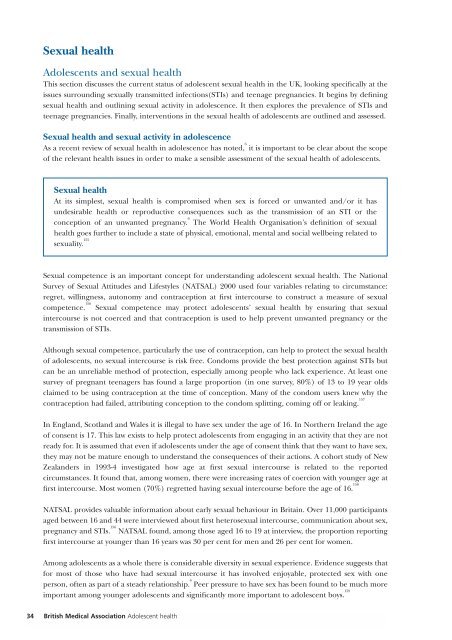Alcohol misuse: tackling the UK epidemic - London
Alcohol misuse: tackling the UK epidemic - London
Alcohol misuse: tackling the UK epidemic - London
You also want an ePaper? Increase the reach of your titles
YUMPU automatically turns print PDFs into web optimized ePapers that Google loves.
34<br />
Sexual health<br />
Adolescents and sexual health<br />
This section discusses <strong>the</strong> current status of adolescent sexual health in <strong>the</strong> <strong>UK</strong>, looking specifically at <strong>the</strong><br />
issues surrounding sexually transmitted infections(STIs) and teenage pregnancies. It begins by defining<br />
sexual health and outlining sexual activity in adolescence. It <strong>the</strong>n explores <strong>the</strong> prevalence of STIs and<br />
teenage pregnancies. Finally, interventions in <strong>the</strong> sexual health of adolescents are outlined and assessed.<br />
Sexual health and sexual activity in adolescence<br />
As a recent review of sexual health in adolescence has noted, 6<br />
it is important to be clear about <strong>the</strong> scope<br />
of <strong>the</strong> relevant health issues in order to make a sensible assessment of <strong>the</strong> sexual health of adolescents.<br />
Sexual health<br />
At its simplest, sexual health is compromised when sex is forced or unwanted and/or it has<br />
undesirable health or reproductive consequences such as <strong>the</strong> transmission of an STI or <strong>the</strong><br />
conception of an unwanted pregnancy. 6<br />
The World Health Organisation’s definition of sexual<br />
health goes fur<strong>the</strong>r to include a state of physical, emotional, mental and social wellbeing related to<br />
sexuality. 155<br />
Sexual competence is an important concept for understanding adolescent sexual health. The National<br />
Survey of Sexual Attitudes and Lifestyles (NATSAL) 2000 used four variables relating to circumstance:<br />
regret, willingness, autonomy and contraception at first intercourse to construct a measure of sexual<br />
competence. 156<br />
Sexual competence may protect adolescents’ sexual health by ensuring that sexual<br />
intercourse is not coerced and that contraception is used to help prevent unwanted pregnancy or <strong>the</strong><br />
transmission of STIs.<br />
Although sexual competence, particularly <strong>the</strong> use of contraception, can help to protect <strong>the</strong> sexual health<br />
of adolescents, no sexual intercourse is risk free. Condoms provide <strong>the</strong> best protection against STIs but<br />
can be an unreliable method of protection, especially among people who lack experience. At least one<br />
survey of pregnant teenagers has found a large proportion (in one survey, 80%) of 13 to 19 year olds<br />
claimed to be using contraception at <strong>the</strong> time of conception. Many of <strong>the</strong> condom users knew why <strong>the</strong><br />
contraception had failed, attributing conception to <strong>the</strong> condom splitting, coming off or leaking. 157<br />
In England, Scotland and Wales it is illegal to have sex under <strong>the</strong> age of 16. In Nor<strong>the</strong>rn Ireland <strong>the</strong> age<br />
of consent is 17. This law exists to help protect adolescents from engaging in an activity that <strong>the</strong>y are not<br />
ready for. It is assumed that even if adolescents under <strong>the</strong> age of consent think that <strong>the</strong>y want to have sex,<br />
<strong>the</strong>y may not be mature enough to understand <strong>the</strong> consequences of <strong>the</strong>ir actions. A cohort study of New<br />
Zealanders in 1993-4 investigated how age at first sexual intercourse is related to <strong>the</strong> reported<br />
circumstances. It found that, among women, <strong>the</strong>re were increasing rates of coercion with younger age at<br />
first intercourse. Most women (70%) regretted having sexual intercourse before <strong>the</strong> age of 16. 158<br />
NATSAL provides valuable information about early sexual behaviour in Britain. Over 11,000 participants<br />
aged between 16 and 44 were interviewed about first heterosexual intercourse, communication about sex,<br />
pregnancy and STIs. 156<br />
NATSAL found, among those aged 16 to 19 at interview, <strong>the</strong> proportion reporting<br />
first intercourse at younger than 16 years was 30 per cent for men and 26 per cent for women.<br />
Among adolescents as a whole <strong>the</strong>re is considerable diversity in sexual experience. Evidence suggests that<br />
for most of those who have had sexual intercourse it has involved enjoyable, protected sex with one<br />
person, often as part of a steady relationship. 6<br />
Peer pressure to have sex has been found to be much more<br />
important among younger adolescents and significantly more important to adolescent boys. 159<br />
British Medical Association Adolescent health
















